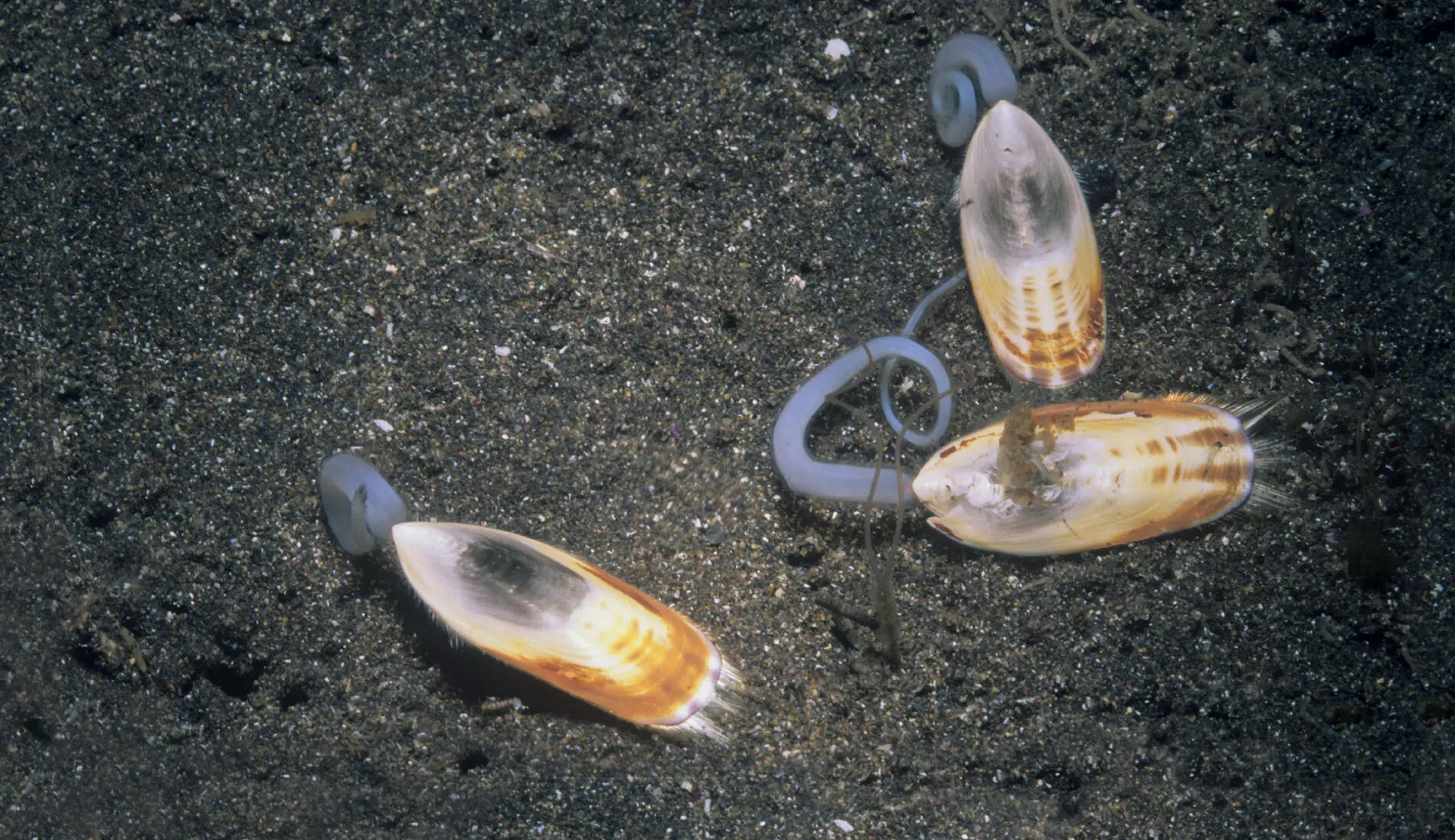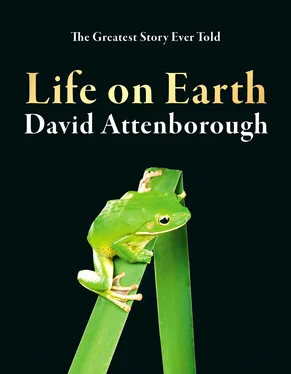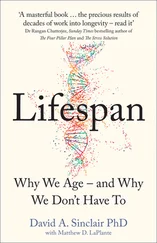1 ...6 7 8 10 11 12 ...20 Flatworms are very simple creatures. Members of one free-swimming group lack a gut altogether and look very like the tiny free-swimming coral organisms before they settle down to a sedentary life. So there is little difficulty in believing those researchers who conclude from a study of the detailed structure of both adult and larva that the flatworms are descended from simpler organisms like corals and jellyfish.
During the period when these first marine invertebrates were evolving, between 600 and 1,000 million years ago, erosion of the continents was producing great expanses of mud and sand on the seabed around the continental margins. This environment must have contained abundant food in the form of organic detritus falling from the waters above as the single-celled organisms that floated in the surface waters died and drifted downwards. It also offered concealment and protection for any creature that lived within it. The flatworm shape, however, is not suited to burrowing. A tubular form is much more effective, and eventually worms with such a shape appeared. Some became active burrowers, tunnelling through the mud in search of food particles. Others lived half buried with their front end above the sediment. Cilia around their mouths created a current of water and from it they filtered their food.
Some of these creatures lived in a protective tube. In time, the shape of the top of this was modified into a collar with slits in it. This improved the flow of water over the tentacles. Further modification and mineralisation eventually produced a two-part protective shell around the front end. These were the first brachiopods, including Lingulella , an example of a species that has existed virtually unchanged for hundreds of millions of years.
The front end of a brachiopod is really quite complicated. Within the shell, it has a mouth surrounded by a group of tentacles. They are covered with beating cilia which create a current in the water. Any food particles in it are caught by the tentacles and then passed by them down to the mouth. While doing this, the tentacles perform another and important function, for the water brings with it dissolved oxygen which the animal needs in order to respire. The tentacles absorb it and so, in effect, they become gills. The shell enclosing the tentacles not only gives protection to these soft delicate structures, but concentrates the water into a steady stream so that it flows more effectively over them.
The brachiopods elaborated this design considerably over the next million years or so. One group developed a hole at the hinge end of one of the valves through which the worm-like stalk emerged to fasten the animal into the mud. This gave the shell the look of an upside-down Aladdin oil lamp, with the stalk as the wick, and so the group as a whole gained the name of lamp shell. The tentacles within the shell eventually became so enlarged that they had to be supported by delicate spirals of limestone.
There are other shelled worms to be found alongside the brachiopods in these ancient rocks. In one kind the elaborated worm did not attach itself to the seafloor but continued to crawl about and secreted a small conical tent of shell under which it could huddle when in danger. This was the ancestor of the most successful group of all these shelled worms, the molluscs, and it too has a living representative, a tiny organism called Neopilina , which was dredged up in 1952 from the depths of the Pacific. Today there are about 80,000 different species of molluscs with about as many again known from their fossils. You can find some of them in your garden; they are the snails and the slugs.

Brachiopods ( Glottidia albida ).
The lower part of the molluscan body is called the foot. Its owner moves itself about by protruding the foot from the shell and rippling its undersurface. Many species carry a small disc of shell on the side of it which, when the foot is retracted into the shell, forms a close-fitting lid to the entrance. The upper surface of the body is formed by a thin sheet that cloaks the internal organs and is appropriately called the mantle. In a cavity between the mantle and the central part of the body, most species have gills which are continually bathed by a current of oxygen-bearing water, sucked in at one end of the cavity and expelled at the other.
The shell is secreted by the upper surface of the mantle. One whole group of molluscs has single shells. The limpet, like Neopilina , produces shell at an equal rate right round the circumference of the mantle and so builds a simple pyramid. In other species, the front of the mantle secretes faster than the rear and creates a shell in a flat spiral, like a watch spring. In yet others, maximum production comes from one side so that the shell develops a twist and becomes a turret. The cowrie concentrates its secretion along the sides of the mantle, forming a shell like a loosely clenched fist. From the slit along the bottom, it protrudes not only its foot but two sections of its mantle which in life may extend over each flank of the shell and meet at the top. These lay down the marvellously patterned and polished surface characteristic of cowries.
Blue limpet ( Patella coerulea ), showing underside.
The single-shelled molluscs feed not with tentacles within the shell like the brachiopods but with a radula, a ribbon-shaped tongue, covered with rasping teeth. Some use it to scrape algae from the rocks. Whelks have developed a radula on a stalk which they can extend beyond the shell and use to bore into the shells of other molluscs. Through the holes they have drilled, they poke the tip of the radula and suck out the flesh of their victim. Cone shells also have a stalked radula but have modified it into a kind of gun. They slyly extend it towards their prey – a worm or even a fish – and then discharge a tiny glassy harpoon from the end. While the tethered victim struggles, they inject a venom so virulent that it kills a fish instantly and can even be lethal to human beings. They then haul the prey back to the shell and slowly engulf it.
A heavy shell must be something of a handicap when actively hunting, and some carnivorous molluscs have taken to a faster if riskier life by doing without it altogether and reverting to the lifestyle of their flatworm-like ancestors. These are the sea slugs (nudibranchs) and they are among the most beautiful and highly coloured of all invertebrates in the sea. Their long soft bodies are covered on the upper side with waving tentacles of the most delicate colours, banded, striped and patterned in many shades. Though they lack a shell, they are not entirely defenceless, for some have acquired secondhand weapons. These species float near the surface of the water on their feathery extended tentacles and hunt jellyfish. As the sea slug slowly eats its way into its drifting helpless prey, the stinging cells of the victim are taken into its gut, complete and unsprung. Eventually these migrate within the sea slug’s tissues and are concentrated in the tentacles on its back. There they give just the same protection to their new owners as they did to the jellyfish that developed them.
Other molluscs, such as mussels and clams, have shells divided into two valves lke those of a brachiopod and thus are known as bivalves. These creatures are much less mobile. The foot is reduced to a protrusion that they use to pull themselves down into the sand. For the most part, they are filter feeders, lying with valves agape, sucking water in through one end of the mantle cavity and squirting it out through a tubular siphon at the other. Since they do not need to move, great size is no disadvantage. Giant clams on the reef may grow to be a metre long. They lie embedded in the coral, their mantles fully exposed, a zigzag of brilliant green flesh spotted with black, which pulsates gently as water is pumped through it. They can certainly be quite big enough for a diver to put his foot into, but he would have to be very incautious indeed to get trapped. Powerful though the clam’s muscles are, it cannot slam its valves shut. It can only heave them slowly together, and that gives plenty of notice of its intentions. What is more, even when the valves of a really large specimen are fully closed, they only meet at the spikes on the edge. The gaps between them are so big that if you plunge your arm through into the mantle, the clam is quite unable to grip it – though the experiment is a little less unnerving if it is tried first with a thick stick.
Читать дальше













